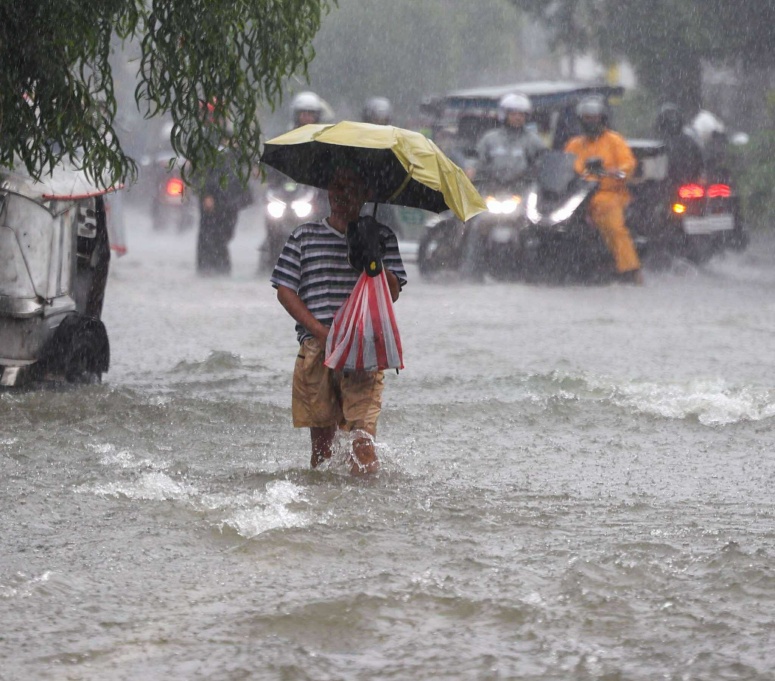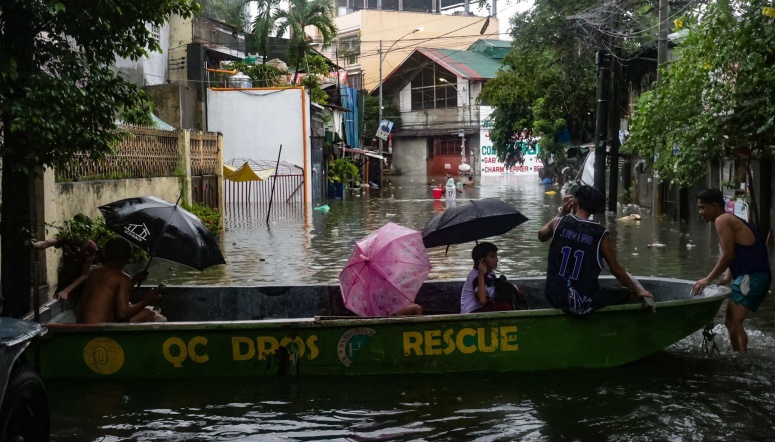EXPLAINER: Why does the Philippines still experience severe flooding despite billions of flood control budget?
The habagat-induced rains have turned different parts of the Philippines into a waterworld all over again. They have inundated roads, displaced families, and caused significant property damage mostly in Luzon areas, including Metro Manila.
Flooding in the country is nothing new at best and expected at worst. It’s been a perennial problem especially during the rainy season, which officially started in June.
The fact that the country experiences an average of 20 typhoons annually supposedly means preparedness is at hand. But once the rains pour, everything else just seems to overflow: traffic, drainage, rivers, even public patience.
In a Facebook post, economist JC Punongbayan questioned why flooding persists despite having billions of pesos in flood control allocations over the years.
Using data from the Department of Budget and Management, he shared a graph showing the steadily increasing flood control allocations: P141.6 billion in 2021, P209.9 billion in 2022, P282.5 billion in 2023, and P351.3 billion in 2024. This year’s allocation stands at P349.4 billion and, despite being less than the previous year’s allocation, Punongbayan noted it’s still roughly a third of the national infrastructure budget.
“Bakit grabe pa rin ang baha?” he asked. “Bakit parang hindi ramdam ang pagbuhos ng budget sa flood control systems?”
Quezon City Mayor Joy Belmonte, during a flag-raising ceremony in the city on July 21, noted that some parts of the city that didn’t experience flooding before already do now. According to her, it has something to do with the national government’s infrastructure projects, particularly the MRT-7.
Just recently, the Metro Manila Development Authority attributed the construction site of the MRT-7 Batasan Station along Commonwealth Avenue to flooding in the area. In response, DPWH Sec. Manuel Bonoan said they’d conduct an inspection and give technical recommendations. Department of Transportation Sec. Vince Dizon, meanwhile, cast doubts over the MMDA’s pronouncement, though expressed openness to coordinating with the DPWH.
What could really be the reasons why flooding is still this bad in the country despite billions of flood control budget?
Decades of poor decisions
Glenn Banaguas—an award-winning scientist who specializes in environmental stewardship, climate change mitigation and adaptation, and disaster risk reduction—told PhilSTAR L!fe that the country's flooding problem is not simply a seasonal occurrence but rather “a persistent reality that reflects the deeper vulnerabilities in our systems, our planning, and our priorities.”
“Despite the many efforts over the years, from infrastructure development to disaster preparedness programs, the truth is that we are still playing catch-up with a crisis that has evolved faster than our response,” he said.

Mahar Lagmay, executive director of Project NOAH (Nationwide Operational Assessment of Hazards), pointed out that today’s flooding crisis is the consequence of decades of poor decisions.
“Sinusubukan nating ayusin 'yung mga bagay na ginawa nating mali,” he said. “Sa Metro Manila, nagsimula ito matagal na.”
He cited the capital’s rapid population growth, now at 15.2 million, which has made urban planning difficult. In turn, many communities had to be built even in flood-prone zones, like riverbanks, creeks, and estuaries.
“Most of the time, itong mga lugar na ito, hindi puno ng tubig pero kapag malakas ang ulan—at madalas na ito—umaapaw ito,” he said.
In a Facebook post, Lagmay pointed out how roads have been built over our supposed natural waterways in the city.
“Daanan talaga siya ng tubig pero nilapatan natin ng kalye,” he wrote.
Banaguas also underscored the urban development model, noting that drainage systems, "many of which were designed for a different era, are no longer capable of handling the volume of water we now receive."
In a recent radio interview, Bonoan acknowledged that Metro Manila has a “very old” drainage system that isn’t “adequate” in dealing with floods nowadays.
“Gumagana po 'yung pumping stations. Ang problema lang po, hindi makadaloy ‘yung tubig-baha papunta sa pumping stations," he said. “’Yung drainage system in Metro Manila is actually very old. 'Yung huling assessment ng drainage system in Metro Manila... 70% of it is actually silted na po.”
He shared that a new drainage system master plan was being developed with the assistance of the World Bank.
Banaguas also connected the more frequent flooding to climate change, noting that the rains today aren’t the same as those of decades past.
“The intensity, frequency, and unpredictability of rainfall have increased dramatically,” he said. “Even tropical cyclones that do not make landfall can now enhance the southwest monsoon and trigger widespread flooding. This is not just about weather—it’s about a climate system that has become more volatile, and we are seeing the consequences in real time.”
Lagmay echoed this, noting that big floods occurring once every 100 years now happen once every 10 years.
“Kalaban natin ang kalikasan at ang mga ginawa natin noong pagkakamali,” he said. “Buhos tayo nang buhos ng pera, among other things, sinusubukan natin ang ad hoc solutions, eh andoon na ang problema.”
What can be done
Despite the bleak outlook, Banaguas and Lagmay believe solutions are within reach, only if there’s a long-term vision and imaginative approach.
“We need to ensure that development is not just about progress,” Banaguas said, “but about protective progress where every structure is designed with resilience in mind.”
The climate scientist suggested having a science-based master plan that integrates engineering, environmental protection, and social equity.
“Our current approach is often piecemeal, standalone projects that offer short-term relief but lack long-term coherence. We need a roadmap that connects river basins, urban centers, and coastal zones under one resilient vision,” he said.
He also stressed the need for embracing nature as a partner in dealing with the flooding problem through restoring wetlands, protecting mangroves, and allowing rivers to follow their natural course.
“These nature-based solutions are not just environmentally sound—they’re cost-effective and community-friendly. When we give water space to flow, we give people space to breathe," he said.

Lagmay echoed these points, adding the need to decongest the metropolis and doing away with property development in crucial areas.
“Don’t make it worse. Panatilihin anuman ang free spaces pa into possible catch basins,” he said. “Walang ilalagay na settlements. Hindi lang puro tayo nang tayo. There must be a change in mindset and strategy.”
He also cited looking at best practices, like the Netherlands’ “Room for the River” program. As the name suggests, the program lets rivers expand into floodplains by dismantling dikes, creating water buffers, relocating levees, increasing the depth of side channels, and constructing flood bypasses.
“It's high time that before we build any structure, we must create the scenarios first. Gamitin natin ang mga teknolohiya para malaman kung uubra ba ang mga plano at walang sisihan,” he added.
While governance is a deeper challenge in addressing the flooding problem, Banaguas pointed out that the most powerful changes often begin at the grassroots.
“We often think that solving the flooding crisis is the job of engineers, government officials, or international experts,” he said. “But the truth is, every Filipino has a role to play.”
He noted that flooding isn’t just caused by rains but also human behavior, including throwing garbage in canals, blocking esteros with illegal structures, or ignoring environmental laws.
“We must start with awareness and accountability,” he said. “Proper waste disposal, community cleanups, and respecting zoning regulations may seem small but they are acts of prevention. When we care for our ecosystems, we care for our safety.”

Lagmay, meanwhile, warned that there is no “Country B,” and the Philippines must come together not only to prevent more floods but also to build a better future. “Wala tayong choice,” he said. “Kailangang gawan natin ng paraan. We have to do it by hook or by crook.”
Ultimately, Banaguas urged everybody to hold on to hope and solidarity.
"Flooding may be a recurring challenge, but Filipinos are known for resilience, creativity, and compassion," he said. "When we combine those traits with knowledge and action, we become more than survivors. We become protectors."
"We don’t need titles to lead. We don’t need power to make a difference. We just need the courage to care, the wisdom to act, and the belief that even the smallest effort can ripple outward," he said, "because in the face of rising waters, it’s not just the government that must rise, it’s all of us."


